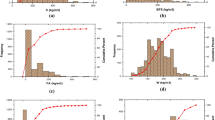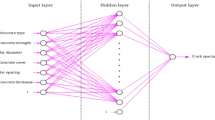Abstract
The tensile behavior of hybrid fiber reinforced concrete (HFRC) is important to the design of HFRC and HFRC structure. This study used an artificial neural network (ANN) model to describe the tensile behavior of HFRC. This ANN model can describe well the tensile stress-strain curve of HFRC with the consideration of 23 features of HFRC. In the model, three methods to process output features (no-processed, mid-processed, and processed) are discussed and the mid-processed method is recommended to achieve a better reproduction of the experimental data. This means the strain should be normalized while the stress doesn’t need normalization. To prepare the database of the model, both many direct tensile test results and the relevant literature data are collected. Moreover, a traditional equation-based model is also established and compared with the ANN model. The results show that the ANN model has a better prediction than the equation-based model in terms of the tensile stress-strain curve, tensile strength, and strain corresponding to tensile strength of HFRC. Finally, the sensitivity analysis of the ANN model is also performed to analyze the contribution of each input feature to the tensile strength and strain corresponding to tensile strength. The mechanical properties of plain concrete make the main contribution to the tensile strength and strain corresponding to tensile strength, while steel fibers tend to make more contributions to these two items than PVA fibers.
Similar content being viewed by others
References
Gong C, Ding W, Mosalam K M, Günay S, Soga K. Comparison of the structural behavior of reinforced concrete and steel fiber reinforced concrete tunnel segmental joints. Tunnelling and Underground Space Technology, 2017, 68: 38–57
Stoll F, Saliba J E, Casper L E. Experimental study of CFRP-prestressed high-strength concrete bridge beams. Composite Structures, 2000, 49(2): 191–200
Sim J, Park C, Moon D Y. Characteristics of basalt fiber as a strengthening material for concrete structures. Composites Part B, Engineering, 2005, 36(6–7): 504–512
Xu L, Xu H, Chi Y, Zhang Y. Experimental study on tensile strength of steel-polypropylene hybrid fiber reinforced concrete. Advanced Science Letters, 2011, 4(3): 911–916
Nguyen D L, Kim D J, Ryu G S, Koh K T. Size effect on flexural behavior of ultra-high-performance hybrid fiber-reinforced concrete. Composites Part B, Engineering, 2013, 45(1): 1104–1116
Wu Z, Shi C, He W, Wang D. Static and dynamic compressive properties of ultra-high performance concrete (UHPC) with hybrid steel fiber reinforcements. Cement and Concrete Composites, 2017, 79: 148–157
Liu F, Ding W, Qiao Y. An experimental investigation on the integral waterproofing capacity of polypropylene fiber concrete with fly ash and slag powder. Construction & Building Materials, 2019, 212: 675–686
Mu R, Miao C, Luo X, Sun W. Interaction between loading, freezethaw cycles, and chloride salt attack of concrete with and without steel fiber reinforcement. Cement and Concrete Research, 2002, 32(7): 1061–1066
Liu F, Ding W, Qiao Y. Experimental investigation on the tensile behavior of hybrid steel-PVA fiber reinforced concrete containing fly ash and slag powder. Construction & Building Materials, 2020, 241: 118000
Zhou Y, Xiao Y, Gu A, Zhong G, Feng S. Orthogonal experimental investigation of steel-PVA fiber-reinforced concrete and its uniaxial constitutive model. Construction & Building Materials, 2019, 197: 615–625
Liu F, Ding W, Qiao Y. Experimental investigation on the flexural behavior of hybrid steel-PVA fiber reinforced concrete containing fly ash and slag powder. Construction & Building Materials, 2019, 228: 116706
Lawler J, Wilhelm T, Zampini D, Shah S P. Fracture processes of hybrid fiber-reinforced mortar. Materials and Structures, 2003, 36(3): 197–208
Lawler J S, Zampini D, Shah S P. Microfiber and macrofiber hybrid fiber-reinforced concrete. Journal of Materials in Civil Engineering, 2005, 17(5): 595–604
Nguyen D L, Ryu G S, Koh K T, Kim D J. Size and geometry dependent tensile behavior of ultra-high-performance fiber-reinforced concrete. Composites. Part B, Engineering, 2014, 58: 279–292
Pujadas P, Blanco A, Cavalaro S, Aguado A. Plastic fibres as the only reinforcement for flat suspended slabs: Experimental investigation and numerical simulation. Construction & Building Materials, 2014, 57: 92–104
Hsie M, Tu C, Song P. Mechanical properties of polypropylene hybrid fiber-reinforced concrete. Materials Science and Engineering A, 2008, 494(1–2): 153–157
Chi Y, Xu L, Yu H. Constitutive modeling of steel-polypropylene hybrid fiber reinforced concrete using a non-associated plasticity and its numerical implementation. Composite Structures, 2014, 111: 497–509
Chi Y, Xu L, Zhang Y. Experimental study on hybrid fiber-reinforced concrete subjected to uniaxial compression. Journal of Materials in Civil Engineering, 2014, 26(2): 211–218
Açikgenç M, Ulaş M, Alyamaç K E. Using an artificial neural network to predict mix compositions of steel fiber-reinforced concrete. Arabian Journal for Science and Engineering, 2015, 40(2): 407–419
Mashhadban H, Kutanaei S S, Sayarinejad M A. Prediction and modeling of mechanical properties in fiber reinforced self-compacting concrete using particle swarm optimization algorithm and artificial neural network. Construction & Building Materials, 2016, 119: 277–287
Jiang K, Han Q, Bai Y, Du X. Data-driven ultimate conditions prediction and stress-strain model for FRP-confined concrete. Composite Structures, 2020, 242: 112094
Hamdia K M, Zhuang X, Rabczuk T. An efficient optimization approach for designing machine learning models based on genetic algorithm. Neural Computing & Applications, 2020 (in press)
Hamdia K M, Lahmer T, Nguyen-Thoi T, Rabczuk T. Predicting the fracture toughness of PNCs: A stochastic approach based on ANN and ANFIS. Computational Materials Science, 2015, 102: 304–313
Hamdia KM, Ghasemi H, Zhuang X, Alajlan N, Rabczuk T. Computational machine learning representation for the flexoelectricity effect in truncated pyramid structures. Computers, Materials & Continua, 2019, 59(1): 79–87
Guo H, Zhuang X, Rabczuk T. A deep collocation method for the bending analysis of Kirchhoff plate. Computers, Materials & Continua, 2019, 59(2): 433–456
Anitescu C, Atroshchenko E, Alajlan N, Rabczuk T. Artificial neural network methods for the solution of second order boundary value problems. Computers, Materials & Continua, 2019, 59(1): 345–359
Samaniego E, Anitescu C, Goswami S, Nguyen-Thanh V M, Guo H, Hamdia K, Zhuang X, Rabczuk T. An energy approach to the solution of partial differential equations in computational mechanics via machine learning: Concepts, implementation and applications. Computer Methods in Applied Mechanics and Engineering, 2020, 362: 112790
Pizarroso J, Portela J, Muñoz A. NeuralSens: Sensitivity analysis of neural networks. 2020, arXiv preprint arXiv:200211423
Saltelli A. Sensitivity analysis for importance assessment. Risk Analysis, 2002, 22(3): 579–590
Shojaeefard M H, Akbari M, Tahani M, Farhani F. Sensitivity analysis of the artificial neural network outputs in friction stir lap joining of aluminum to brass. Advances in Materials Science and Engineering, 2013, 2013: 574914
Stone M. Cross-validatory choice and assessment of statistical predictions. Journal of the Royal Statistical Society. Series B. Methodological, 1974, 36(2): 111–133
Nair V, Hinton G E. Rectified linear units improve restricted Boltzmann machines. In: Proceedings of the 27th International Conference on Machine Learning (ICML-10). Haifa, 2010, 807–814
Liu B. Study on Durability and Mechanical Properties of Hybrid Fiber Reinforced Concrete. Thesis for the Master’s Degree. Jinzhou: Liaoning University of Technology, 2019
Yang K H. Tests on concrete reinforced with hybrid or monolithic steel and polyvinyl alcohol fibers. ACI Materials Journal, 2011, 108(6): 664–672
Hai R, Liu J, Zhang M, Zhang L. Performance of hybrid steel-polyvinyl alcohol fiber reinforced ultra high performance concrete. Concrete (China), 2016, 319: 95–97
Pedregosa F, Varoquaux G, Gramfort A, Michel V, Thirion B, Grisel O, Blondel M, Prettenhofer P, Weiss R, Dubourg V, Vanderplas J, Passos A, Cournapeau D, Brucher M, Perrot M, Duchesnay E. Scikit-learn: Machine learning in Python. The Journal of Machine Learning Research, 2011, 12: 2825–2830
Paszke A, Gross S, Massa F, Lerer A, Bradbury J, Chanan G, Killeen T, Lin Z, Gimelshein N, Antiga L, Desmaison A, Köpf A, Yang E, DeVito Z, Raison M, Tejani A, Chilamkurthy S, Steiner B, Fang L, Bai J, Chintala S. PyTorch: An imperative style, high-performance deep learning library. In: Advances in Neural Information Processing Systems. 2019, 8026–8037
Marian Tietz T J F, Daniel N, Benjamin B. Skorch: A Scikit-Learn Compatible Neural Network Library that Wraps PyTorch. 2017
Kingma D P, Ba J. Adam: A method for stochastic optimization. 2014, arXiv preprint arXiv:14126980
Cortes C, Vapnik V. Support-vector networks. Machine Learning, 1995, 20(3): 273–297
Breiman L. Random forests. Machine Learning, 2001, 45(1): 5–32
Rasmussen C E. Gaussian Processes in Machine Learning. Springer: Summer School on Machine Learning, 2003, 63–71
Chinese Standard. Code for Design of Concrete Structures (GB 50010-2010). Beijing: China Building Industry Press, 2010
Acknowledgements
The authors would like to acknowledge the National Natural Science Foundation of China (Grant Nos. 51978515, 41941018), Shanghai Sailing Program (19YF1451400), and Shanghai Municipal Science and Technology Major Project (2017SHZDZX02) for their financial support.
Author information
Authors and Affiliations
Corresponding authors
Rights and permissions
About this article
Cite this article
Liu, F., Ding, W., Qiao, Y. et al. An artificial neural network model on tensile behavior of hybrid steel-PVA fiber reinforced concrete containing fly ash and slag power. Front. Struct. Civ. Eng. 14, 1299–1315 (2020). https://doi.org/10.1007/s11709-020-0712-6
Received:
Accepted:
Published:
Issue Date:
DOI: https://doi.org/10.1007/s11709-020-0712-6




